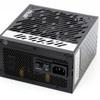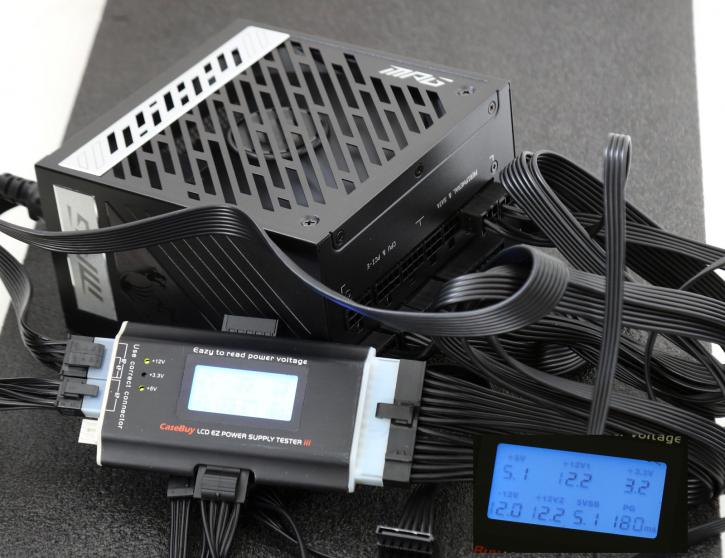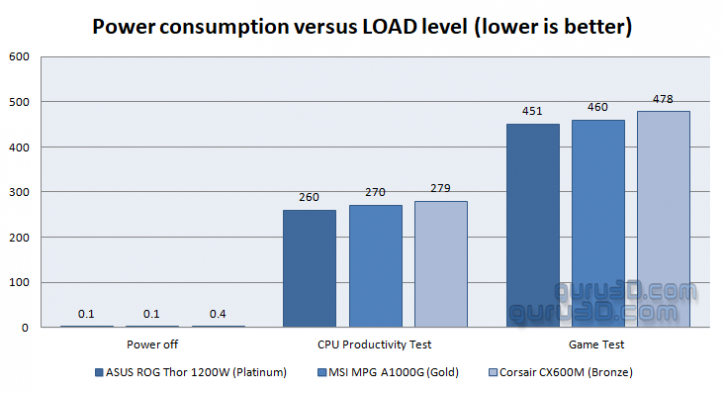Load Testing The PSU
Load Testing The PSU
Nowadays, putting a power supply through its paces is a bit of a challenge. That is to say, it is quite difficult to put stress on a power supply of this caliber and actually quantify its behavior without the assistance of experienced load testers.
Our first check is with a simple power supply tester, we monitor voltages quickly and check if all rails are working properly and within spec (spot-on perfect actually). It also has a nice self-check immediately indicating it the voltages are at a proper stage.
Load and efficiency testing
For our power supply reviews, we emulate real-world usage and make use of a rather old energy-hungry multi-GPU ready motherboard armed with an accompanying processor. Depending on the power supply wattage we then make use of one or more graphics cards. Older processors and GPUs eat much more power. With power supplies getting so efficient these days, reaching over 600 Watts is actually a challenging task. Then, on the software side of things, it is time to give the PC a decent beating. Remember, our focus remains on PSU efficiency, not the components we use.
In the above plot, these are the wattage differences we talk about these days. So while overall a generic bronze-rated power supply is less efficient, they are cheaper to purchase. The difference under ~50% load from all PSUs we have tested (from top to bottom) is roughly 40 Watts. Looking at powered down efficiency is a relatively easy thing to accomplish, gather data. We look at the powered-off status (ErP/EuP), productivity mode (we stress the CPUs), and finally, during gaming. The lower the Wattage, the more efficient the PSU, it is that simple.
Following EU legislation your PC and thus PSU and motherboard combo need to remain under 0.5 Watts in sleep or power-down mode. We measure 0.1 Watts. To achieve this, you will need to enable EuP mode in your motherboard BIOS. Our equipment cannot measure below 0.1 Watts so that is the lowest value we can measure.
Guru3D RGB Tip: the RGB lit motherboards are transcending to look at. Nonetheless, if you leave RGB bling activated on their motherboard day and night even with the PC powered down, you are using roughly 5 to 10 Watts continuously 24/7/365. Each Watt used on a yearly basis will cost you 1.5 to 2 USD/EUR depending on your energy rates. Our advice, look up the BIOS settings and make sure it's disabled when powered down.
When we focus solely on CPU productivity mode load for a second we see that the PSU draws 269W, measured on the wall socket side. CPU productivity would be video-transcoding, content creation etc, all your processor's logical cores are 100% at work while your graphics card is doing nothing. It makes sense for lower wattage PSUs to be a bit more efficient here as opposed to Kilowatt+ PSUs.
Probably the best indicator for the Guru3D community, is efficient power consumption by looking at a game test. We explained a couple of times already that at 50% load, a PSU is usually at its most efficient so this one is performing well.
Guideline tip: If your graphics card will consume 200W, add 100W for 100% CPU load and add 25W for say your mobo chipset and extras like HDD/SSDs. Then your load usage would be roughly 325 Watt. In this scenario at 50% being the most efficient, a 650W PSU would be the logical choice. A 1000W model is more suited for a draw of 500W, that's an enthusiast-class PC with say a GeForceRTX 3090 and Alder Lake processor.






